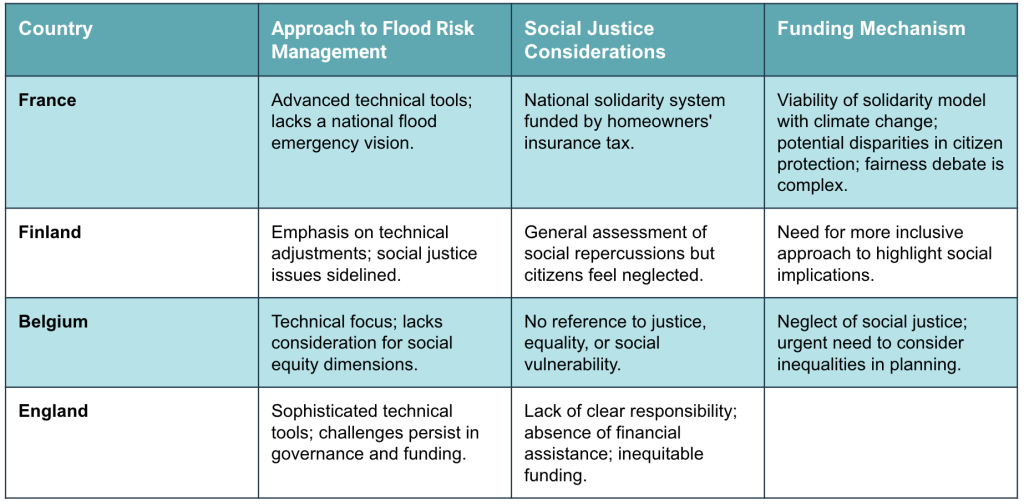1. Adapting resources to situations
The management of natural risks, such as floods and coastal erosion, requires a holistic approach where Social justice must be at the core of Adaptation strategies. As illustrated in various national examples, the diversity of technical tools deployed demonstrates the magnitude of challenges faced by decision-makers. However, a common observation emerges: Social justice is often overlooked in the allocation and implementation of these resources.
In France, for example, flood Risk management plans incorporate advanced technical tools, but the absence of a national flood emergency vision highlights a major gap in resource coordination. The dispersion of responsibilities and local plans can potentially create disparities in citizen protection, thereby accentuating social inequalities in the face of risks. The national Solidarity system established since 1982, funded by a tax on homeowners’ insurance, illustrates the country’s commitment to collective protection. The question of whether this national Solidarity model is economically viable with Climate change is relevant, as some natural risks, such as coastal erosion, may no longer be compensated. This raises questions about the long-term Sustainability of this system in the face of Climate change. Some argue that it is not always fair, as those who are not flooded and contribute would prefer residents in flood-prone areas to bear higher and more proportional costs. However, there are several aspects to consider. Firstly, this approach assumes that real estate agencies might be tempted to conceal the fact that a property is in a flood-prone area if such an event were to occur. Additionally, the French tradition of national Solidarity plays a significant role in this debate, making any potential reform complex and controversial.
In Finland, despite a general assessment of social impacts in management plans, issues of Social justice and Inequality seem to be relegated to the background. Technical adjustments, such as the Säpilänniemi channel, demonstrate a priority given to the immediate resolution of problems rather than a thorough consideration of long-term Social justice. The Flood Risk Management Plan (FRMP) incorporates a general assessment of social repercussions. However, affected citizens express a sense of neglect. Although impact assessment is conducted, it appears insufficient to fully encompass social concerns. This gap underscores the need for a more inclusive approach, highlighting social implications more comprehensively.
In Belgium, the technical orientation of flood Risk management plans results in a lack of consideration for the social dimensions of Equity. The absence of reference to Justice, Equality, or social Vulnerability underscores a crucial gap in resource planning, where principles related to their allocation are addressed only in relation to drought (referring to the case studies in the web documentary). The lack of specific attention to Social justice in flood Risk management is concerning. Impacts are primarily assessed in terms of buildings and Disaster compensation, thus neglecting social nuances. This approach highlights a pressing need to consider social inequalities in resource planning and Adaptation measures.
In England, despite the implementation of sophisticated technical tools, challenges persist. The lack of clear responsibility for flood Risk management, the absence of financial assistance for property owners, and inequitable funding raise fundamental questions about Equity in Risk Adaptation. Poorly defined Governance, coupled with insufficient resident information, creates an environment where inequalities in flood Risk persist. Inequitable funding exacerbates these disparities. Better clarification of Governance and more transparent communication are needed to ensure a fair distribution of resources and information.
The analysis of different national contexts emphasizes that Social justice is often sidelined in natural Risk management. Adapting resources to Risk situations must imperatively incorporate a perspective of Social justice to ensure a fair distribution of benefits and protections. Technical and legal tools must be developed considering social diversity and the specific vulnerabilities of communities to build resilient and just solutions for all.
2. Growing inequalities in the face of flood risks
The rising Risk of floods, exacerbated by Climate change, highlights a alarming picture of social inequalities in the face of these challenges, requiring an immediate and equitable response in Risk management. The examined national plans underscore a common challenge: the increasing flood-related inequalities. In France, the dispersion of responsibilities and the absence of national emergency coordination leave the most vulnerable communities without a coherent approach, accentuating socio-economic disparities.
The observation is similar in Finland, where technical adjustments to address floods often focus on immediate solutions. However, these approaches may Risk overlooking the social Vulnerability specific to Climate change, thereby exacerbating existing inequalities.
In Belgium, the technical orientation of flood Risk management plans presents an additional challenge. The lack of reference to Social justice underscores a crucial gap, while resource allocation principles may worsen disparities in the context of Climate change.
In England, inequalities in the face of flood risks persist, with disadvantaged populations often being the most affected. The lack of clear responsibility and financial assistance further accentuates these inequalities, highlighting the urgency of an equitable response.
Overall, these findings call for a response centered on Social justice. Consideration of Climate change must guide Adaptation plans, ensuring that resources are allocated in a way that does not worsen existing inequalities. It is imperative that technical and legal strategies incorporate an equitable perspective to build resilient societies where everyone, regardless of socio-economic status, benefits from adequate protection against flood risks.
Want to go further?

